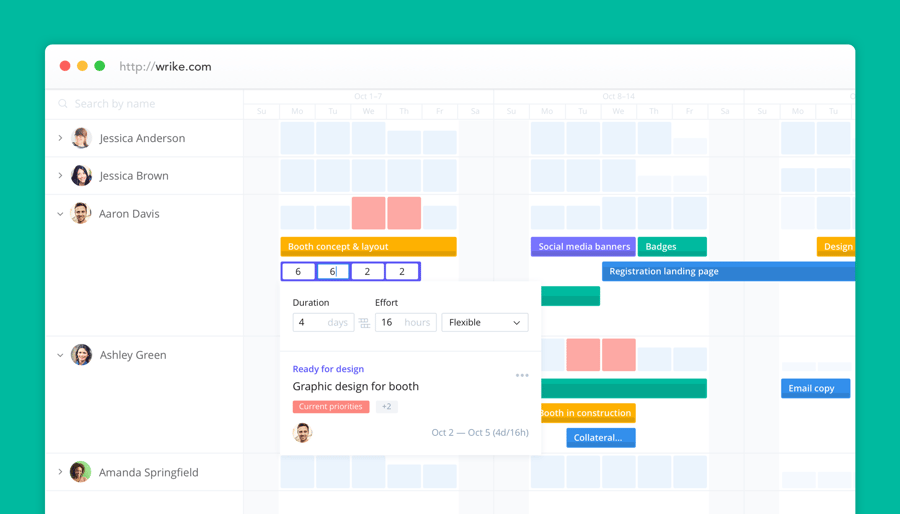Key takeaways:
- What is the future of remote work? Remote work is here to stay, with organizations adopting fully remote or hybrid models long-term.
- How has resource management changed? The shift to remote work has created new challenges in efficiently managing resources and preventing employee burnout.
- What tools can assist in resource allocation? Enhanced project resource planning features in Wrike enable accurate forecasting, prioritization, and workload balancing.
- How can teams increase efficiency? By evaluating resource availability and needs through Wrike’s new planner, teams can optimize effort allocation without additional resources.
- Why is visibility crucial in resource management? Full visibility into resource distribution allows managers to quickly adapt workloads and ensure project delivery.
It’s evident that remote work will survive the pandemic, and many organizations have already announced that they’ll operate remotely for good. Others will continue using the hybrid model. Beyond what all this means in terms of operations, collaboration, and planning, remote work also alters the way organizations will be building out and executing their plans for economic recovery.
An essential part of economic recovery planning involves managing all your resources in the most efficient and economical way possible. Resource management is already difficult enough at scale and becomes more problematic when teams are distributed, and as the volume of incoming requests and initiatives increases.
In 2022, teams need more to help them plan with confidence
There’s more to the story of why there’s now a greater need for resource management solutions. As most teams moved to a fully remote and/or hybrid model, three notable changes occurred.
- Work habits shifted. According to Stanford research, 42% of the U.S. labor force is now working from home full time. Following stay-at-home orders, the average workday lengthened by 48.5 minutes, and the number of meetings increased by 13%.
- Collaboration and communication changed. Digital communication took center stage with distributed teams, as they relied heavily on digital tools to meet face-to-face and hold events. While this provided a solution to real-time collaboration, many experienced “Zoom fatigue” as a result of too many on-screen meetings.
- Novel resource allocation issues arose. Companies needed an effective way to balance initiatives and resources to ensure successful delivery — all while minimizing employee burnout due to things like longer workdays and Zoom fatigue. Because businesses also had to become hyper-vigilant of profitability during economic uncertainty, team leaders had to focus on accomplishing more with existing resources.
So the challenge many now face is, “How do I increase efficiency and decrease fatigued employees with no additional resources?”
Now more than ever, organizations and managers need an accurate and efficient way to evaluate resource needs and availability to ensure successful delivery, optimized resource utilization, and employee satisfaction.
Simplify planning with new resource management enhancements in Wrike
New enhancements to project resource planning capabilities are now available in Wrike. With these new enhancements, team leaders and project managers can ensure successful project delivery while balancing employee workload with an easier way to optimize resource planning, utilization, and effort allocation across the entire project portfolio.
The new project resource planner maximizes planning accuracy by allowing team leaders and project managers to forecast resource needs and evaluate scheduling scenarios before assigning work to team members. You can prioritize projects by comparing resource needs against actual availability, and assign work based on skill and capacity.
The new resource planner acts as a scratchpad to visualize and plan out which resources you need for a project before assigning actual work to team members. Project managers can create resource requests indicating how many hours they’ll need for a project. These requests then funnel to team leaders, who can approve the request by assigning the work. Or, if required team members don’t have enough free time to work on the project, team managers can collaborate with project managers to reprioritize work and resolve conflict.
When allocating effort, project managers and team leaders can now set the daily amount of a team member’s capacity as either a percentage or number of hours. This functionality eliminates the need for manual calculations while allowing team members to work on multiple initiatives simultaneously.
Leaders need to be able to see resource needs across the entire portfolio so they can adjust employee workload to accommodate those needs. With full visibility into resource distribution across all projects, project managers can monitor resourcing status in real time, and quickly shift resources to achieve on-target delivery.
These new enhancements enable team leaders and managers to manage employee workload by:
- Ensuring team members can handle new projects by first evaluating user or job role capacity before delegating work.
- Quickly addressing backlog and balancing team workload by dragging and dropping work to available resources, or redistributing work to alleviate overburdened team members.
Project and program managers can optimize resource planning by:
- Accurately planning project resource needs to ensure on-target delivery.
- Identifying resource gaps and easily reassigning critical resources to high-priority initiatives with visibility into workload distribution across the entire portfolio.
See how Wrike’s new resource management enhancements can help you do your best work: Contact us to request a demo today.










